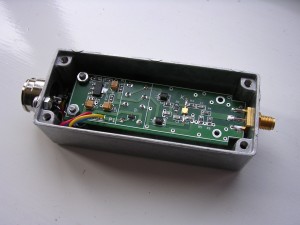We meet Tuesday evenings 19:45 for 20:00, Thursday mornings 10:00 and Sundays 14:00. Tuesdays and Sundays are hybrid in person and Zoom meetings (Join us in person or using zoom, code 867 3049 5863) Thursday mornings are exclusively in person, see schedule below or contact us for more details.
Event Information:
-
Calibrated noise source - W0IYH
Information To Support Radcom Article "The Measurement of Noise" by Dave Roberts G8KBB Jan 2007
Hi Chaps. Enclosed in a Zip file for downloading are the following:
1. Copy of original article from QST (also reproduced in ARRL handbook for last few years)
2. Copy of datasheet on noise diode
3. Copy of datasheet on relay
4. Circuit diagram of proposed board
5. PCB layout showing PCB overlaid on standard diecast box
6. Bill of Materials (excludes box)
7. Spreadsheet showing stock numbers from Digikey and APPROXIMATE prices
Printed Circuit Board
The PCB is simple but in the interests of ease I propose to put 6 on 1 PCB and get it done as a prototype via George's friendly manufacturer as a good quality board. It is designed to fit into a standard 92x38x27 diecast box but you may want to do otherwise. The PCB output connection is deliberately long so that it can be cut down to fit different connector styles. It is a 50 ohm microstripline to avoid discontinuities assuming εr of FR4, 62 thou laminate and 2 oz copper.
 Output may be via any connector you fancy. I plan to use an SMA. The specific one I'm looking to use fits on the edge of the PCB directly and solders in place. It has a slightly longer barrel and a screw mounting. By all means though use whatever makes sense for you (BNC, N etc.). I'll not order SMAs unless anyone specifically asks (I have not checked to see that an N flange will fit but it probably will).
Output may be via any connector you fancy. I plan to use an SMA. The specific one I'm looking to use fits on the edge of the PCB directly and solders in place. It has a slightly longer barrel and a screw mounting. By all means though use whatever makes sense for you (BNC, N etc.). I'll not order SMAs unless anyone specifically asks (I have not checked to see that an N flange will fit but it probably will).Input in the original article is 20V stabilised. I've included a regulator and more smoothing on the assumption that it is easier to feed 24-30V than worry about calibration of the 20V every time you use it. Also the original article had a switch for reversing the current through the diode - I've put a relay on so that it can be remotely controlled. Just fit a switch to energise the relay. Solid state switching would be better - if anyone has a simple circuit to suggest, tell me.
Calibration needs to be sorted out. One possibility is that Noise/Com will calibrate a unit and the others can be calibrated from that.
Ordering instructions are included in the download file.



